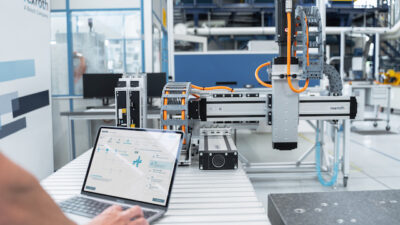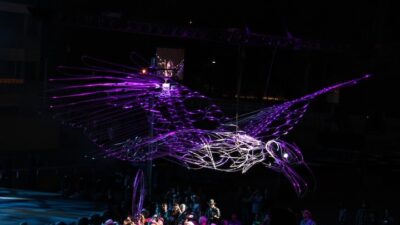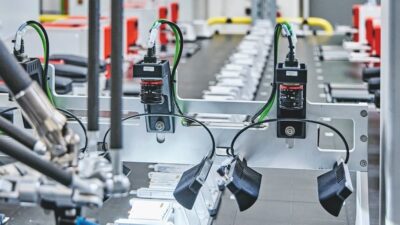One trend from the recent IMTS '98 show sure to appeal to control engineers is the merging of PC technology with CNCs (Computer Numerical Control). Application of PCs to CNCs varies from an "open" solution comprised of CNC motion control software running on any PC that meets specifications to adding chipsets with the desired functions to existing CNC boards.
KEY WORDS
Machine control
Computer numerical control
PC-based control
Motion control
One trend from the recent IMTS ’98 show sure to appeal to control engineers is the merging of PC technology with CNCs (Computer Numerical Control). Application of PCs to CNCs varies from an “open” solution comprised of CNC motion control software running on any PC that meets specifications to adding chipsets with the desired functions to existing CNC boards.
Why make these changes to a mature stable control architecture? Mark Devonshire, CNC marketing manager at Rockwell Automation (Mayfield Heights, O.) says, “One reason for looking at PC technology was because people saw these things on their desks and thought they could be used for motion control. PCs allow capabilities beyond traditional CNCs in communications, HMI, and the ability to leverage commercial software. People are tired of making investments in proprietary utilities when there were tools like editors, VBA (Visual Basic for Applications) for HMI, and standards from office environment that were known.”
“Flexibility and integration,” says Stewart Patterson, GE Fanuc Automation’s (Charlottesville, Va.) CNC marketing manager. “Flexibility includes the ability to use custom interfaces and create unique applications. Integration is the ability to interconnect the CNC with other systems, machines, and programs, including communication options ranging from man-to-machine through the enterprise and to the Internet.”
Improving total productivity
George Yamane, marketing manager for Mazak Corp. (Florence, Ky.) notes, “More sophisticated shapes are involved with added tooling capability and up to 20-80 tools. On top of this, managers expect more productivity: faster, accurate machining; reduce scrap; and, more capacity in programming. It’s tough to gain much more from traditional methods, for example, spindle speed has gone from 4,000 to 10,000 rpm. Improvements must come from total manufacturing processing, not just machining productivity. Issues include how to keep the machine fully loaded and faster program downloads.”
“To improve this,” Mr. Yamane continues, “we must provide more information to help maintenance troubleshoot a problem more efficiently and allow the operator to make quicker adjustments. Mazak’s Navigational simulation functions help get optimum cutting conditions, accumulate data, and add to knowledge base. These are benefits of using PC technology as part of the machining process.”
Richard Rey, Indramat’s CNC account executive (Rexroth Corp., Hoffman Estates, Ill.), says, “PCs at the machine are great, because they allow larger storage for part programs at the machine, the ability to make network connections, and run third party software. But one thing a PC-based control should not sacrifice is control functionality.”
Many engineers are convinced that solutions using PC technology with open hardware platforms and software with open APIs (application program interface) are cost effective alternatives to proprietary systems. OMAC (Open Modular Architecture Control) is a voluntary organization of companies dedicated to providing open solutions.
Four companies have demonstrated a joint effort to build an OMAC solution for open systems based on Real-time Control System Methodology. The CNC Material Handling demonstration included Metrex Division of Extrude Hone’s (Irwin, Pa.) Profile View NT, Advanced Technology & Research Corp.’s (Burtonsville, Md.) open CNC control, material handling control from ObjectAutomation (Santa Ana, Calif.), and integrated by Real Time Development Corp. (Laurel, Md.). The controllers run on Microsoft Windows NT with Real Time Extensions by VenturCom Inc. (Cambridge, Mass.).
Jerry Yen, manager of Advanced Manufacturing Control Systems at General Motors Powertrain and a leader of OMAC, says, “The prototype controller of the Extrude Hone surface inspection system demonstrates the ease of technology integration in an open environment from multiple vendors.”
Software CNC
OpenCNC for Windows NT from MDSI (Ann Arbor, Mich.) is now available for shipment. Announced at IMTS ’98 in September, OpenCNC had been running on a machine in actual manufacturing for over four months before a public release. Worried about Blue Screen of Death (BSOD)? “There was no failure of the product due either to BSOD or other causes,” says James Fall, vice president of marketing.
With an unbundled software solution, customers pick their own hardware to get the best cost. The complete API is published so customers can integrate whatever custom interfaces, programs, or routines they wish. OpenCNC provides for real-time data collection, which can be made available over a plant network or the internet. Users can also run SPC software, view CAD drawings, edit part programs, or design software to capture data.
Mazak announced the Mazatrol Fusion 640 at IMTS ’98. This RISC (Reduced Instruction Set Computer) processor offers 64-bit control plus, an on-board PC. The PC has bi-directional communications with the numerical controller. The PC software is browser-compatible, letting users surf for data from the machine just as if they were using the Internet. Mazak has improved diagnostic capability and installed features designed to help plant managers improve overall manufacturing efficiency. Programming is done via Mazak’s conversational tool eliminating the need to know G- and M-codes for most part programming. The Navigational tool simulates a machining process reporting suggested methods of improving the process.
MeldasMagic 64 PC-NC is a CNC on a PC board from Mitsubishi Electric Automation (Vernon Hills, Ill.). It is available alone or bundled with Mitsubishi’s industrial PC. This 64-bit RISC processor handles up to seven axes plus four auxiliary axes for such applications as turret indexing and tool magazine control. MeldasMagic 64 provides 32 kB/16 K steps of PLC ladder memory and controls up to 512 inputs and 512 outputs using remote I/O modules. The bundled version comes with Windows 95 and Mitsubishi’s standard HMI software. Users can develop customized screens using Visual Basic or Visual C[++]. One advantage of this package is its ability to run CNC programs from the computer’s hard drive.
PC-based CNC
MachineMate CNC is a PC-based CNC from Giddings & Lewis (Fond du Lac, Wis.). It runs on Windows NT with a real-time kernel. Targeted to the OEM and retrofit markets, it supports both analog and SERCOS drives. Retrofit applications are enhanced by ease of communications, while OEMs like the customization inherent in PC-based software. The control supports all five IEC 61131-3 languages for PLC applications.
Allen-Bradley’s 9/PC (Rockwell Automation/Allen-Bradley, Mayfield Heights, O.) is a PC-based CNC offering open interfaces for servo, part programming, communication, HMI, logic, and I/O control. Equipped with DDE- (Dynamic Data Exchange) and OPC- (Object Linking and Embedding for Process Control) compliant APIs, 9/PC users can interface third party software applications leveraging available software compatible with Windows NT. HMI is developed using Visual Basic providing for customization by users. Part programs can be stored on the hard drive and can be integrated with CAD/CAM packages. There is a SERCOS link to servos. 9/PC uses DeviceNet to communicate with I/O devices. The machine logic engine is SoftLogix 5, a software version of the AB PLC-5.
GE Fanuc Automation combines the PC and CNC. In addition to dedicated processors for CNC control, logic control (PMC), and servo control, another processor controls the display and creates a two-way channel into the CNC displaying CNC information and allows process changes based on external factors. Each processor is designed to optimize a specific task, reducing overhead and bottlenecks. The Windows 95 or NT interface provides operators, programmers, and engineers with a familiar view into the CNC. Cimplicity HMI for CNC software supports the new processors. The PC connects into the backplane of the CNC either directly or via a 25 Mb fiber-optic connection. Additional software packages released for open architecture controllers include DNC Operation Management providing a way to handle applications with part programs too large to store in CNC memory and Milling Animation which shows operators a 3D image of the part along with the milling motion from the part program.
Indramat offers MTC200, a family of PC-based, open-architecture control modules. This is part of the System200 concept with control components designed as modules that can be connected into a control system suitable for the specific application. Hardware modules are available for CNC, PLC, HMI, and I/O control functions. CNC and PLC modules are offered as plug-in PC cards or for rack mounting. They can control up to 32 machine axes, up to seven independent processes, and 8,192 I/O points. Industry standards such as Windows NT, IEC 61131-3 programming, SERCOS fiber-optic drive interface, and networking buses Interbus, Profibus, and DeviceNet are supported.
Norman Bleier, Siemens Energy & Automation’s (Elk Grove Village, Ill.) engineering manager, says adding PC-based open front end to the Sinumerik 840D numerical control system has improved the user’s ability to customize the interface. It also allows process and tool monitoring systems from various manufacturers to be integrated. Several suppliers are marketing visualization systems based on the Sinumerik 840D. This Windows NT system facilitates direct access to internal data such as spindle current consumption, real output, and torque. The process of design to drawing to part program is enhanced by adding CAD packages such as Virtual Gibbs to the PC.



